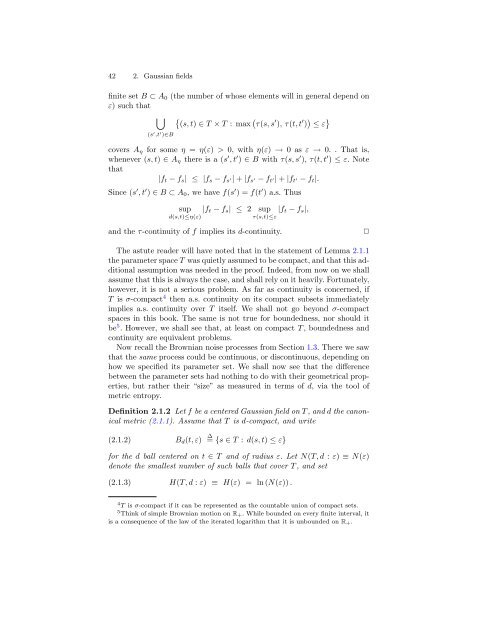You also want an ePaper? Increase the reach of your titles
YUMPU automatically turns print PDFs into web optimized ePapers that Google loves.
42 2. Gaussian fields<br />
finite set B ⊂ A0 (the number of whose elements will in general depend on<br />
ε) such that<br />
� � � � �<br />
′ ′<br />
(s, t) ∈ T × T : max τ(s, s ), τ(t, t ) ≤ ε<br />
(s ′ ,t ′ )∈B<br />
covers Aη for some η = η(ε) > 0, with η(ε) → 0 as ε → 0. . That is,<br />
whenever (s, t) ∈ Aη there is a (s ′ , t ′ ) ∈ B with τ(s, s ′ ), τ(t, t ′ ) ≤ ε. Note<br />
that<br />
|ft − fs| ≤ |fs − fs ′| + |fs ′ − ft ′| + |ft ′ − ft|.<br />
Since (s ′ , t ′ ) ∈ B ⊂ A0, we have f(s ′ ) = f(t ′ ) a.s. Thus<br />
sup |ft − fs| ≤ 2 sup |ft − fs|,<br />
d(s,t)≤η(ε)<br />
τ(s,t)≤ε<br />
and the τ-continuity of f implies its d-continuity. ✷<br />
The astute reader will have noted that in the statement of Lemma 2.1.1<br />
the parameter space T was quietly assumed to be compact, and that this additional<br />
assumption was needed in the proof. Indeed, from now on we shall<br />
assume that this is always the case, and shall rely on it heavily. Fortunately,<br />
however, it is not a serious problem. As far as continuity is concerned, if<br />
T is σ-compact 4 then a.s. continuity on its compact subsets immediately<br />
implies a.s. continuity over T itself. We shall not go beyond σ-compact<br />
spaces in this book. The same is not true for boundedness, nor should it<br />
be 5 . However, we shall see that, at least on compact T , boundedness and<br />
continuity are equivalent problems.<br />
Now recall the Brownian noise processes from Section 1.3. There we saw<br />
that the same process could be continuous, or discontinuous, depending on<br />
how we specified its parameter set. We shall now see that the difference<br />
between the parameter sets had nothing to do with their geometrical properties,<br />
but rather their “size” as measured in terms of d, via the tool of<br />
metric entropy.<br />
Definition 2.1.2 Let f be a centered Gaussian field on T , and d the canonical<br />
metric (2.1.1). Assume that T is d-compact, and write<br />
(2.1.2)<br />
Bd(t, ε) ∆ = {s ∈ T : d(s, t) ≤ ε}<br />
for the d ball centered on t ∈ T and of radius ε. Let N(T, d : ε) ≡ N(ε)<br />
denote the smallest number of such balls that cover T , and set<br />
(2.1.3)<br />
H(T, d : ε) ≡ H(ε) = ln (N(ε)) .<br />
4 T is σ-compact if it can be represented as the countable union of compact sets.<br />
5 Think of simple Brownian motion on R+. While bounded on every finite interval, it<br />
is a consequence of the law of the iterated logarithm that it is unbounded on R+.
















